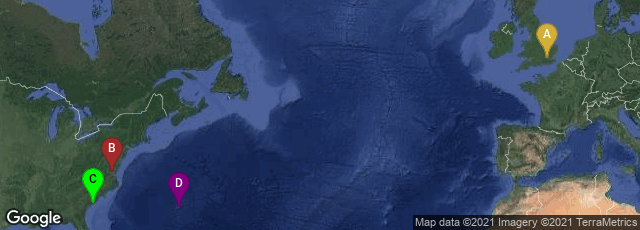
A: London, England, United Kingdom, B: Williamsburg, Virginia, United States, C: Charleston, South Carolina, United States, D: Pembroke, Pembroke Parish, Bermuda
Ivory-billed Woodpecker, Campephilus principalis on Water Oak, Quercus phellos. Hand-colored engraving. Original caption (cropped off here) reads: Picus Maximus rostro albo: The largest white-bill Wood-pecker; Quercus, an potius Ilex Marilandica folio longo angusto Salicis. Ray Hist: The Willow-Oak. Vol. 1, plate 16 from Catesby (1754).
In 1729 Mark Catesby published the Natural History of Carolina, Florida and the Bahama Islands in London "Printed at the Expence of the AUTHOR: and Sold by W. INNYS and R. MANBY, at the West End of St. Paul's, by Mr. HAUKSBEE, at the Royal Society House, and by the AUTHOR, at Mr. BACON'S in Hoxton." This splendid set of 2 folio volumes was the first natural history of North American flora and fauna, with 220 plates engraved by Catesby and colored under his supervision, systematically illustrating American birds, reptiles, amphibians, insects, and mammals for the first time. Catesby was the first to place his birds and animals in their natural habitats, a style of representation that would later be used by Alexander Wilson and John James Audubon. He was also the first to abandon the Native American names for his subjects, trying to establish scientific names based on generic relationships. Linnaeus would use Catesby’s work as the basis for his system of binomial nomenclature for American species in the tenth edition of Systema naturae (1758).
Having studied with the naturalist, John Ray, Catesby made his first trip to America to visit his sister who lived in Williamsburg, Virginia. He returned to England in 1719. On this visit Catesby became intrigued with the strangeness and variety of American plants, birds and animals, and decided to return again to the New World for another extended trip. For this second visit he acquired a number of sponsors for whom he was to collect and sketch botanical samples. Amongst his sponsors were William Sherard and Sir Hans Sloane. Catesby returned to America in 1722, settling in Charlestown, Carolina, and moving to Bermuda in 1725 as the guest of Governor Phenny. On this trip he collected botanical samples for his sponsors, but he also sketched painted the birds, plants and animals that he saw on his wanderings throughout rural Southeastern America.
In 1726 Catesby returned to London and sought funding to produce and publish his researches by subscription. “Catesby worked as a horticulturist first in the nursery of Thomas Fairchild, which passed to the hands Stephen Bacon in 1729, and then in Christopher Gray's nursery in Fulham. His work as a horticulturist and his reputation as an importer of exotic species helped him to generate subscribers for the Natural History as many of his clients read Catesby's work as an 'illustrated catalogue' of the exotic plants Catesby sold.
“Catesby's connections within the Royal Society proved indispensable in financing his American expedition, and they served him equally well in his publication of Natural History; Twenty-nine of his one hundred and fifty-four subscribers were members.Three individual members of the Royal Society were instrumental to producing and publishing the Natural History. Peter Collinson, a wealthy businessman with a keen interest in natural history, lent Catesby "considerable Sums of Money...without interest" and was the main financial supporter of Catesby's work. Sir Hans Sloane, by this time President of the Royal Society, continued to aid Catesby through his own financial support and by helping him enlist subscribers. For help with the Latin names of his subjects, Catesby turned to botanist William Sherard, who had been central in sending Catesby to America in the first place.
“Catesby wanted to send his watercolors to Paris or Amsterdam to be engraved for printing, but the cost was prohibitive. And so, by now in his mid-forties, the self-taught artist endeavored to learn etching. The print maker Joseph Goupy taught Catesby to etch his own plates. His lack of experience and expertise actually served as asset, freeing him to innovate. Instead of the traditional "Graver-like manner" he opted to ‘omit their method of cross-Hatching and to follow the humour of the Feathers, which is more laborious, and I hope has proved more to the purpose’. Each copy was then hand-coloured, though Catesby did have some assistance with this.
“As Catesby sorted through his paintings, deciding which to reproduce, he organized his materials into two volumes. The first hundred images of birds, frequently posed with the plants on which they feed or in which they dwell, would make up Volume I. Volume II was divided into sections treating fish, amphibians, mammals and insects, again, often with related plants. Volume II included plates treating only plants and ended with an appendix, which depicted some animals and plants Catesby was unable to see in person. As a preface to the second volume Catesby wrote a collection of essays discussing the geology, climate and peoples of "Carolina and the Bahama Islands."
“Each volume consists of five parts, each of which Catesby presented to the Royal Society upon completion. While the publication date on the title page of the first volume is 1731, he presented parts I-V between 1729 and 1732. Between 1734 and 1743 he presented parts VI-X, followed by the Appendix in 1747. Catesby sold the sections separately for two guineas a piece. A complete set, at twenty-two guineas, was one of the most expensive works of the 1700s. The order in which these sections of appear vary from copy to copy of the first edition as patrons had the works bound themselves. While Catesby's original proposal for publication stated that a smaller uncolored set would also be available for a single guinea a section, no known black and white copies exist” (http://xroads.virginia.edu/~ma02/amacker/etext/pre_3.htm, accessed 12-28-2008).
In February 2014 all the images and captions from Catesby’s work could be viewed at the website created by Kristy Amaker at this link.
In 2007 The Catesby Commemorative Trust produced a beautiful film about Catesby's life and work entitled The Curious Mister Catesby.